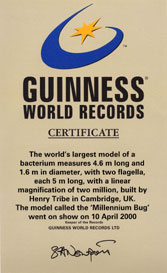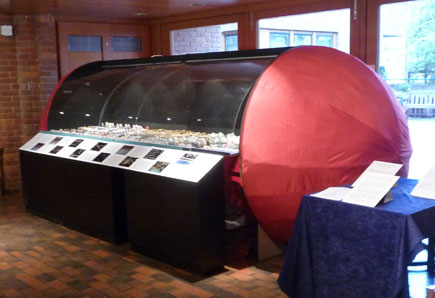E.coli Model
Some time before the Millennium I suggested to the Society for General Microbiology (SGM) that a model of the bacterium E.coli magnified two million times be constructed in order to further public understanding of microorganisms at the Millennium. E.coli in particular because this bacterium had caused several well publicised outbreaks of lethal food poisoning in Scotland at the time and was much in the news. The Society considered that such a model would be prohibitively expensive but that if I were willing to design and make it they would set aside a small grant for construction of the framework. I therefore designed the cell which was made by local carpenters to enclose a level space of 3x 0.9 metres on which panels of metabolic pathways would be placed.
The purpose of the Model is to show many of the interacting metabolic pathways and structures found in the E.coli cell. The bacterial cell, at some 5 x 2 x 2 metres is the only cell small enough to fit comfortably into an ordinary room: even yeasts or the nucleii of animal and plant cells would require an excessive volume of space.

E.coli model Guiness
World Record
Certificate.

The E.coli model at the Biochemical Society's Annual Symposium Meeting in Robinson College Cambridge, January 2011.
The Model was ready, just, for the SGM Millennial Meeting in Warwick. It then went for some months first to the Liverpool Museum who most kindly designed and provided excellent introductory panels with supports and then to the Life Interactive World Exhibition at Newcastle upon Tyne. Returning to Cambridge it spent short periods during Science Weeks at Cambridge City Library, the CU Department of Biochemistry, Impington Village College and Homerton College Cambridge and later at the EcoTechCentre, Swaffham, Norfolk. For the past four years it provided the centrepiece of my Science Week exhibitions on the theme of Life at two million magnification held during March in the Centre for Lymphology and Feldenkrais in suburban Cambridge and in January 2011 was shown at the Biochemical Society's Annual Symposium Meeting in Robinson College Cambridge.
In the year 2000 the model received a Guinness World Record Certificate as the largest model bacterium and to the author's knowledge the record still stands. It has been extensively revised over the period of its existence.